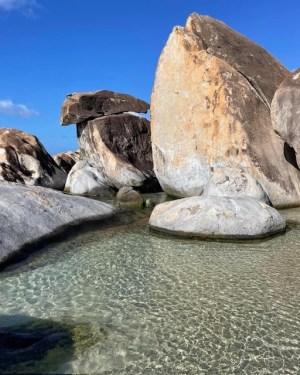Virgin Gorda National Park: Caribbean Paradise Preserved
Virgin Gorda, situated in the British Virgin Islands (BVI), is a gem of the Caribbean, boasting pristine beaches, crystal-clear waters, and a unique blend of natural beauty and cultural richness. At the heart of this paradise lies the Virgin Gorda National Park, a conservation area that encompasses a variety of ecosystems, historical sites, and breathtaking landscapes, contributing to the preservation of the island’s unique natural heritage.
Covering approximately 300 acres, the Virgin Gorda National Park was established in 1974 with the aim of protecting the island’s diverse flora and fauna, as well as its significant historical and geological features. The park is an integral part of the BVI National Parks Trust’s efforts to conserve and sustainably manage the territory’s natural resources. Let’s delve into the fascinating aspects of this national park that make it a must-visit destination for nature enthusiasts, history buffs, and those seeking a tranquil escape.
Geological Wonders:
Virgin Gorda is renowned for its distinctive geological formations, and the national park is home to one of its most iconic landmarks—the Baths. This geological wonder consists of colossal granite boulders strewn across the beach, creating a labyrinth of tunnels, caves, and pools. Visitors can explore this surreal landscape, wading through crystal-clear waters and marveling at the interplay of sunlight and shadows on the smooth surfaces of the boulders.

Devil’s Bay Beach, The Baths
The Baths also serve as a snorkeler’s paradise, with vibrant coral reefs and diverse marine life thriving in the surrounding waters. The park’s commitment to preserving these delicate ecosystems ensures that future generations can continue to witness the underwater wonders that make the Baths a unique and cherished destination.
Breathtaking Beaches:
The Virgin Gorda National Park encompasses several pristine beaches, each with its own distinct charm. Spring Bay, Devil’s Bay, and Savannah Bay are among the most popular. These beaches offer powdery white sand, swaying palm trees, and calm, azure waters, creating a perfect setting for relaxation and recreation.
Devil’s Bay, accessible via a picturesque trail from the Baths, is particularly enchanting with its intimate coves and clear waters. The park’s emphasis on sustainable tourism ensures that these beaches remain unspoiled, allowing visitors to connect with nature in a tranquil and undisturbed environment.
Flora and Fauna:
The national park is a haven for biodiversity, hosting a variety of plant and animal species native to the Caribbean. Dry forests, coastal shrublands, and mangrove swamps are some of the ecosystems found within the park. The conservation efforts of the BVI National Parks Trust play a crucial role in safeguarding these habitats and promoting the coexistence of diverse flora and fauna.
Birdwatchers can delight in the park’s avian residents, including the Caribbean Elaenia and the Zenaida Dove. Meanwhile, the presence of native plants such as the Virgin Gorda Fiddlewood and the Turk’s Cap Cactus adds to the park’s ecological significance.
Historical Significance:
Beyond its natural wonders, the Virgin Gorda National Park also holds historical importance. The island was once a hub for Arawak and Carib communities, and remnants of their presence, such as ancient petroglyphs, can still be found within the park. These petroglyphs provide a glimpse into the rich cultural heritage of the indigenous people who once called Virgin Gorda home.
The park is also home to the ruins of a 19th-century copper mine, reflecting the island’s historical role in mining operations. The park’s management places a strong emphasis on preserving these historical sites, allowing visitors to appreciate the island’s cultural legacy while exploring its natural beauty.
Conservation and Sustainability:
The Virgin Gorda National Park stands as a testament to the commitment to conservation and sustainable practices. The BVI National Parks Trust implements measures to minimize the impact of tourism on the fragile ecosystems, including designated trails and controlled access to sensitive areas.
Educational programs and interpretive signage within the park aim to raise awareness about the importance of conservation. By fostering a sense of environmental responsibility, the park contributes to the long-term preservation of Virgin Gorda’s natural and cultural heritage.
Recreational Activities:
Visitors to the Virgin Gorda National Park have a plethora of recreational activities to choose from. Hiking trails meander through the park, offering opportunities to explore its diverse landscapes and discover hidden gems. Snorkeling and swimming in the clear waters provide a refreshing escape, while picnicking on the pristine beaches allows for a leisurely day surrounded by nature’s beauty.
The park’s accessibility, combined with its well-maintained facilities, makes it an ideal destination for families, adventure seekers, and those looking to unwind in a serene environment.

Beautiful rock formations at The Baths
Visitor Experience and Infrastructure:
To enhance the visitor experience, the Virgin Gorda National Park features well-maintained trails, informative signage, and designated viewing areas. The park management works to strike a balance between facilitating tourism and preserving the natural integrity of the area. Adequate facilities, including restrooms and picnic areas, cater to the needs of visitors, ensuring a comfortable and enjoyable stay.
Guided tours and interpretive programs provide valuable insights into the park’s ecological and historical significance, enriching the overall experience for those eager to delve deeper into the stories that the landscapes and structures hold.
Challenges and Future Conservation:
While the Virgin Gorda National Park has made significant strides in conservation, it faces ongoing challenges, including climate change, invasive species, and the potential impact of increased tourism. The BVI National Parks Trust continues to work on adaptive management strategies to address these challenges and ensure the long-term sustainability of the park.
Community engagement and partnerships with local stakeholders play a vital role in the park’s conservation efforts. By fostering a sense of ownership and responsibility among residents and visitors alike, the park can thrive as a model for sustainable ecotourism.
Conclusion:
In conclusion, the Virgin Gorda National Park stands as a testament to the harmonious coexistence of natural wonders and cultural heritage. From the awe-inspiring Baths to the tranquil beaches, from the rich biodiversity to the historical sites, the park offers a diverse and immersive experience for those seeking to connect with the Caribbean’s pristine beauty.
As an example of conservation and sustainable management, the Virgin Gorda National Park sets a high standard for preserving the delicate balance between human activity and the natural environment. By fostering awareness, appreciation, and responsible tourism practices, the park ensures that future generations can continue to be captivated by the enchanting landscapes and rich history that make Virgin Gorda a true Caribbean treasure.
